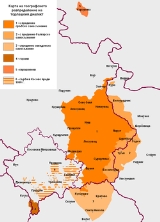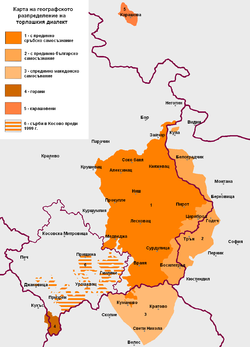
Našinski
Encyclopedia

The Gorani or Našinski (literally meaning "our language") language is the variety of South Slavic
South Slavic languages
The South Slavic languages comprise one of three branches of the Slavic languages. There are approximately 30 million speakers, mainly in the Balkans. These are separated geographically from speakers of the other two Slavic branches by a belt of German, Hungarian and Romanian speakers...
spoken by the Gorani people in the border area between Kosovo
Kosovo
Kosovo is a region in southeastern Europe. Part of the Ottoman Empire for more than five centuries, later the Autonomous Province of Kosovo and Metohija within Serbia...
, Albania
Albania
Albania , officially known as the Republic of Albania , is a country in Southeastern Europe, in the Balkans region. It is bordered by Montenegro to the northwest, Kosovo to the northeast, the Republic of Macedonia to the east and Greece to the south and southeast. It has a coast on the Adriatic Sea...
and Macedonia. It is part of the Torlakian
Torlakian
Torlakian or Torlak is a name given to the group of South Slavic dialects of southeastern Serbia , northeastern Macedonia , western Bulgaria , which is intermediate between Serbian, Bulgarian and Macedonian.Some linguists classify it as an Old-Shtokavian dialect of Serbian or a fourth dialect of...
dialect group which is the transitional dialect between Eastern and Western South Slavic languages
South Slavic languages
The South Slavic languages comprise one of three branches of the Slavic languages. There are approximately 30 million speakers, mainly in the Balkans. These are separated geographically from speakers of the other two Slavic branches by a belt of German, Hungarian and Romanian speakers...
.
Distribution and classification
The dialect is spoken across the Gora regionGora (region)
Gora is a geographical region in southern Serbia and northeastern Albania, inhabited by Albanians and a Gorani minority. The name "Gora" is a Slavic word for "mountain" or "forest"....
. It is spoken in 18 villages in Kosovo, 11 in Albania and 2 in the Republic of Macedonia. In Kosovo and the Republic of Macedonian it is written in either the Serbian
Serbian Cyrillic alphabet
The Serbian Cyrillic alphabet is an adaptation of the Cyrillic script for the Serbian language, developed in 1818 by Serbian linguist Vuk Karadžić. It is one of the two standard modern alphabets used to write the Serbian language, the other being Latin...
or Macedonian Cyrillic Alphabets
Macedonian alphabet
The orthography of Macedonian includes an alphabet , which is an adaptation of the Cyrillic script, as well as language-specific conventions of spelling and punctuation....
, whereas in Albania, the Latin Albanian alphabet
Albanian alphabet
The modern Albanian alphabet is based on the Latin alphabet, and consists of 36 letters:Note: The vowels are shown in bold. to the pronunciation of the letters.-History:...
is used. In the 1991 Yugoslav
Socialist Federal Republic of Yugoslavia
The Socialist Federal Republic of Yugoslavia was the Yugoslav state that existed from the abolition of the Yugoslav monarchy until it was dissolved in 1992 amid the Yugoslav Wars. It was a socialist state and a federation made up of six socialist republics: Bosnia and Herzegovina, Croatia,...
census, 54.8% of the inhabitants of the Gora municipality
Gora (region)
Gora is a geographical region in southern Serbia and northeastern Albania, inhabited by Albanians and a Gorani minority. The name "Gora" is a Slavic word for "mountain" or "forest"....
said that they spoke the Goranian language, roughly in proportion to the number who considered themselves ethnic Gorani. Then a little less than half from the inhabitants of Gora described their language as Serbian
Serbian language
Serbian is a form of Serbo-Croatian, a South Slavic language, spoken by Serbs in Serbia, Bosnia and Herzegovina, Montenegro, Croatia and neighbouring countries....
.
The dialect is related to the neighbouring Prizren
Prizren
Prizren is a historical city located in southern Kosovo. It is the administrative center of the eponymous municipality and district.The city has a population of around 131,247 , mostly Albanians...
-South Morava dialect area to the north-east, which comprises the Serbian/Torlakian varieties spoken in the southern half of Kosovo and in south-eastern Serbia, as well as to the northernmost dialects of Macedonia. In the context of Macedonian dialectology, it is described as having particular close links to the Lower Polog dialect
Lower Polog dialect
The Lower Polog dialect is a member of the western subgroup of the Northern group of dialects of the Macedonian language. It is spoken by the population in north-western Republic of Macedonia. This dialect is spoken in the city Tetovo, in the bigger villages Jegunovce, Vratnica, Tearce, Lešok,...
of the Polog
Polog
Polog also known as the Polog Valley , is located in the north-western part of the Republic of Macedonia near the border with Serbia.It is divided into Upper and Lower Polog...
and Tetovo
Tetovo
Tetovo is a city in the northwestern part of Macedonia, built on the foothills of Šar Mountain and divided by the Pena River.The city covers an area of at above sea level, with a population of 86,580 citizens in the municipality. Tetovo is home to the State University of Tetovo and South East...
regions, which are situated just opposite the Gora area on the other side of the Šar Mountains.
Goranian has also been classified as a part of the Bulgarian dialect
Bulgarian dialects
Bulgarian dialects are the regional spoken varieties of the Bulgarian language, a South Slavic language. Bulgarian dialectology dates to the 1830s and the pioneering work of Neofit Rilski, Bolgarska gramatika...
area, by Bulgarian, as well as some foreign anthropologists. In 2007 the Bulgarian Academy of Sciences
Bulgarian Academy of Sciences
The Bulgarian Academy of Sciences is the National Academy of Bulgaria, established in 1869. The Academy is autonomous and has a Society of Academicians, Correspondent Members and Foreign Members...
sponsored and printed the first Našinski-Albanian
Albanian language
Albanian is an Indo-European language spoken by approximately 7.6 million people, primarily in Albania and Kosovo but also in other areas of the Balkans in which there is an Albanian population, including western Macedonia, southern Montenegro, southern Serbia and northwestern Greece...
dictionary (with 43,000 words and phrases) by Goranian researcher Nazif Dokle who considers the language a Bulgarian dialect.
On the other hand, former Yugoslav linguists Vidoeski, Brozović and Ivić identify the Slavic dialect of the Gora region as Macedonian
Macedonian language
Macedonian is a South Slavic language spoken as a first language by approximately 2–3 million people principally in the region of Macedonia but also in the Macedonian diaspora...
. According to some sources in 2003 the Kosovo government acquired Macedonian language and grammar books to be taught in Gorani schools.
Phonological characteristics
The Gora dialect shares with standard Serbian, the northernmost dialects of Macedonian and western dialects of Bulgarian the vocalisation of earlier syllabic /l/ in words like vuk ('wolf') (cf. Macedonian volk, standard Bulgarian vălk). With Serbian it also shares the reflex of */tj, dj/ as /tɕ/, as opposed to standard Macedonian /c/ (‹ќ›). With the westernmost dialects of Macedonian, as well as most of the Bulgarian dialects, it shares the reflex of "big Yus" (*/ɔ̃/) as /ə/ (ӑ) in words like păt ('road') (cf. Macedonian pat, Serbian put). With standard Macedonian and some Bulgarian dialects it shares the reflexes of */ĭ, ŭ/ as /e, o/ in words like den ('day') and son ('dream'). With standard Macedonian, standard Serbian and some Bulgarian dialects it shares the retention of syllabic /r/ in words like krv ('blood').Examples
- Jas som od Kosharisht. - I am from Kosharisht.
- Srećen rodni den! - Happy birthday!
- Ja zborim Našinski jezik. - I speak Našinski language.
Typical words
Here is a song sung in the typical Gora dialect.-
- Što se beli, gore Šar planina?
- Da l'je snegče, il'je belo stado?
- Nit'je snegče, nit'je belo stado.
- Da je snegče, bi se rastopilo,
- Da je stado, bi se rasturilo.
- Več toj beše Milkino čadorče,
- Pod čadorče bolna Milka lega.
- Brata i gu Turci zarobili,
- Zarobili, paj ga obesili.
Another two songs in Našinski
Našinski
The Gorani or Našinski language is the variety of South Slavic spoken by the Gorani people in the border area between Kosovo, Albania and Macedonia...
, from Shishtejec
Shishtavec
Shishtavec is a village of Kukës District, northeastern Albania. The village consists of 300 households with over 1,800 inhabitants of Gorani ethnicity. The village is part of the wider Gora region...
-
- Verba đurđevdenjova
- Ta šot si gi granke širnala
- Mori verbice đurđevdenova
- Dali jeno gajle sin e mala
- Ja mater som go imala
- Mati mi go gajle galuala
- So mleko presno me ranjila
- Za tija som tenka i visoka
- Za tija som bela i cervena
- Tvuje da ti srec izgore.
-
- Verno libe
- Gledaj me gledja libe, abe verno libe,
- na gledajmise dur ti som ovde.
- Utre ke odim abe vrno libe dalek-dalek
- na pusti Gurbet.
- Racaj po racaj libe šo da ti kupim,
- ti da mi kupiš
- abe gledaniku cerna šamija, ja da ga nosim
- abe gledaniku I da ga želam.
- Racaj po racaj abe verno
- libe šo da ti pratim
- Ti da mi pratiš abe
- gledaniku šarena knjiga
- Ja da ga pujem abe
- gledaniku i da ga želam

